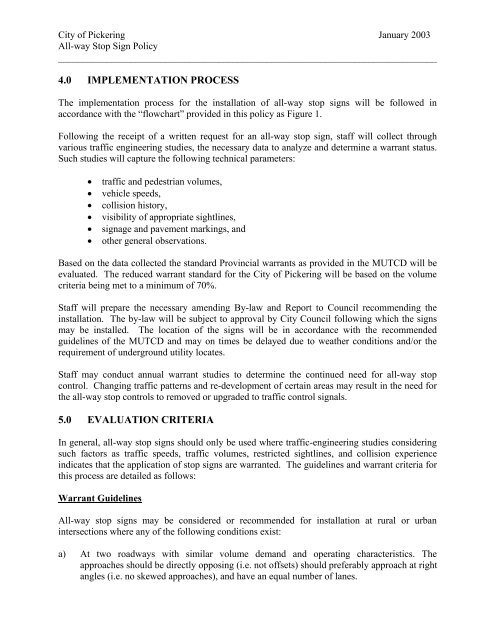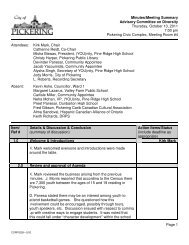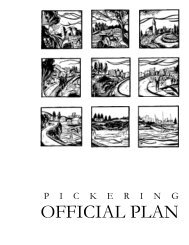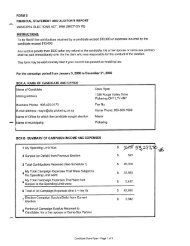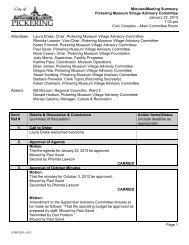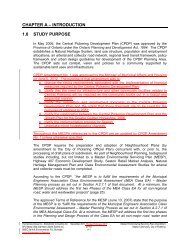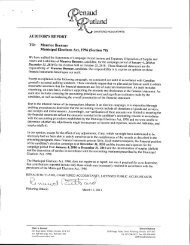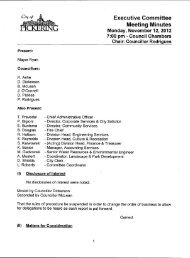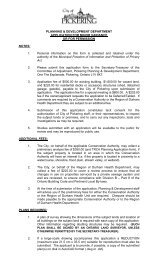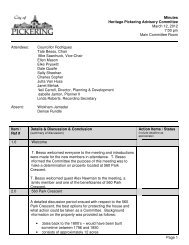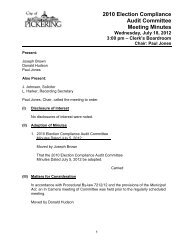foreword - City of Pickering
foreword - City of Pickering
foreword - City of Pickering
You also want an ePaper? Increase the reach of your titles
YUMPU automatically turns print PDFs into web optimized ePapers that Google loves.
<strong>City</strong> <strong>of</strong> <strong>Pickering</strong> January 2003<br />
All-way Stop Sign Policy<br />
______________________________________________________________________________<br />
4.0 IMPLEMENTATION PROCESS<br />
The implementation process for the installation <strong>of</strong> all-way stop signs will be followed in<br />
accordance with the “flowchart” provided in this policy as Figure 1.<br />
Following the receipt <strong>of</strong> a written request for an all-way stop sign, staff will collect through<br />
various traffic engineering studies, the necessary data to analyze and determine a warrant status.<br />
Such studies will capture the following technical parameters:<br />
<br />
<br />
<br />
<br />
<br />
<br />
traffic and pedestrian volumes,<br />
vehicle speeds,<br />
collision history,<br />
visibility <strong>of</strong> appropriate sightlines,<br />
signage and pavement markings, and<br />
other general observations.<br />
Based on the data collected the standard Provincial warrants as provided in the MUTCD will be<br />
evaluated. The reduced warrant standard for the <strong>City</strong> <strong>of</strong> <strong>Pickering</strong> will be based on the volume<br />
criteria being met to a minimum <strong>of</strong> 70%.<br />
Staff will prepare the necessary amending By-law and Report to Council recommending the<br />
installation. The by-law will be subject to approval by <strong>City</strong> Council following which the signs<br />
may be installed. The location <strong>of</strong> the signs will be in accordance with the recommended<br />
guidelines <strong>of</strong> the MUTCD and may on times be delayed due to weather conditions and/or the<br />
requirement <strong>of</strong> underground utility locates.<br />
Staff may conduct annual warrant studies to determine the continued need for all-way stop<br />
control. Changing traffic patterns and re-development <strong>of</strong> certain areas may result in the need for<br />
the all-way stop controls to removed or upgraded to traffic control signals.<br />
5.0 EVALUATION CRITERIA<br />
In general, all-way stop signs should only be used where traffic-engineering studies considering<br />
such factors as traffic speeds, traffic volumes, restricted sightlines, and collision experience<br />
indicates that the application <strong>of</strong> stop signs are warranted. The guidelines and warrant criteria for<br />
this process are detailed as follows:<br />
Warrant Guidelines<br />
All-way stop signs may be considered or recommended for installation at rural or urban<br />
intersections where any <strong>of</strong> the following conditions exist:<br />
a) At two roadways with similar volume demand and operating characteristics. The<br />
approaches should be directly opposing (i.e. not <strong>of</strong>fsets) should preferably approach at right<br />
angles (i.e. no skewed approaches), and have an equal number <strong>of</strong> lanes.


